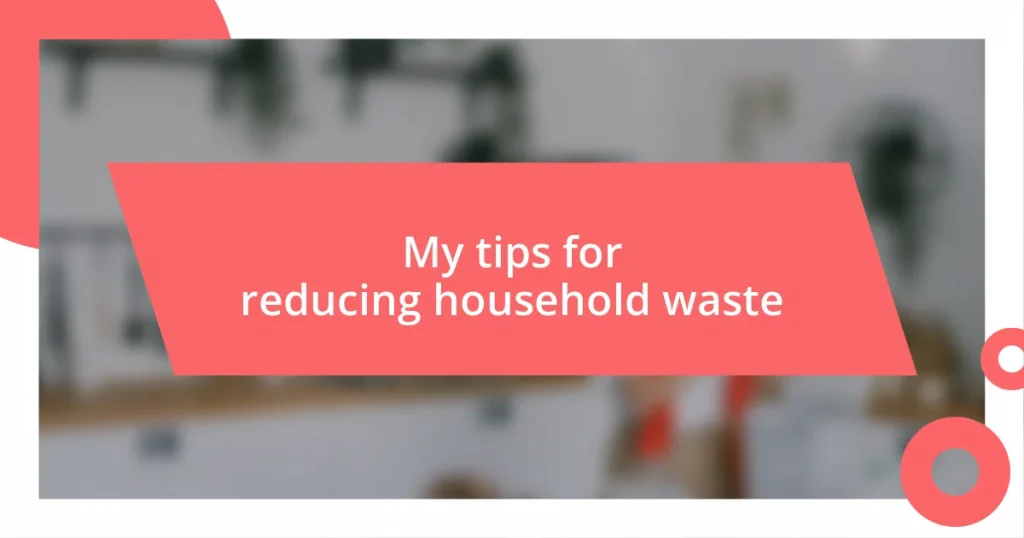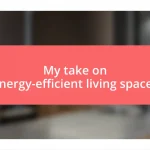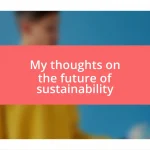Key takeaways:
- Understanding household waste categories (organic, recyclable, non-recyclable) fosters mindful consumption and reduces overall waste.
- Implementing waste reduction strategies, such as meal planning and composting, leads to financial savings, environmental health, and emotional well-being.
- Creating a zero waste plan and engaging the community through activities like swap parties enhance commitment to reducing waste and strengthen social connections.
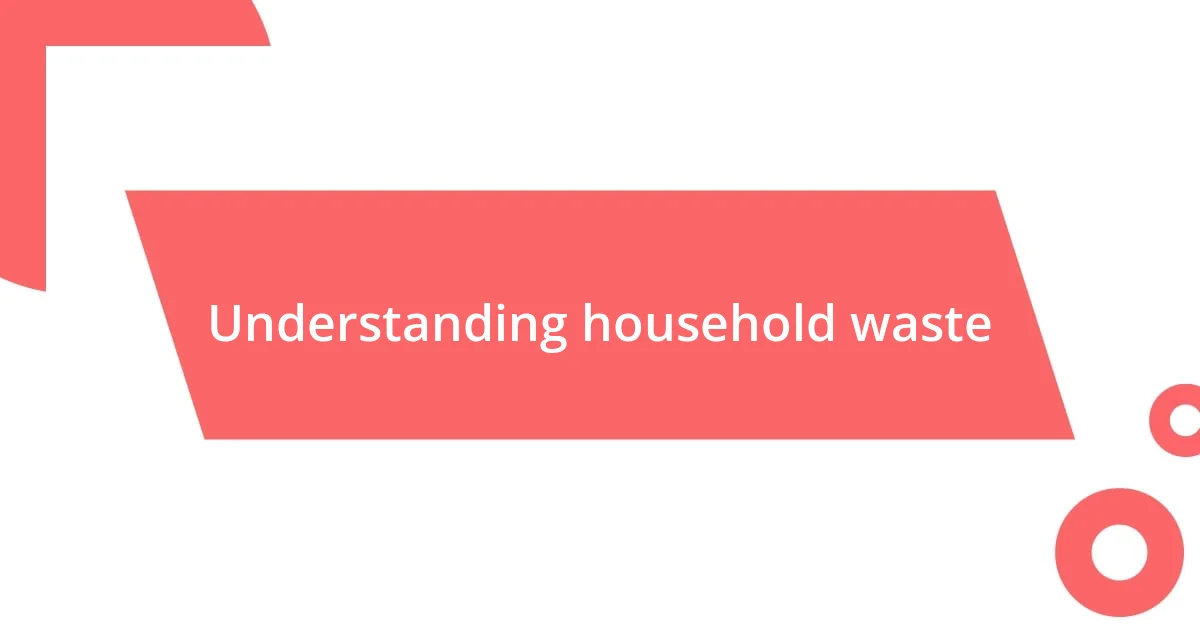
Understanding household waste
Household waste is more than just garbage; it’s a reflection of our consumption habits and lifestyle choices. I remember when I first started paying attention to what I threw away. It was eye-opening to me how much food went into the bin simply because I didn’t plan meals effectively. Have you ever considered how planning might reduce waste in your home?
The types of waste we generate can be categorized into organic, recyclable, and non-recyclable materials. Personally, I’ve found that separating these items in my kitchen has made me more mindful of what I purchase. For example, when I see how many plastics I accumulate, it pushes me to seek alternatives, creating a visceral connection to my environmental impact.
Additionally, understanding household waste involves recognizing its lifecycle—from production to disposal—and the consequences our choices have on the planet. I still find myself occasionally overwhelmed by the vastness of it all. How can something so small like one plastic bottle affect the oceans? Yet, I’ve learned that even small changes can lead to significant shifts over time, making it feel less daunting.
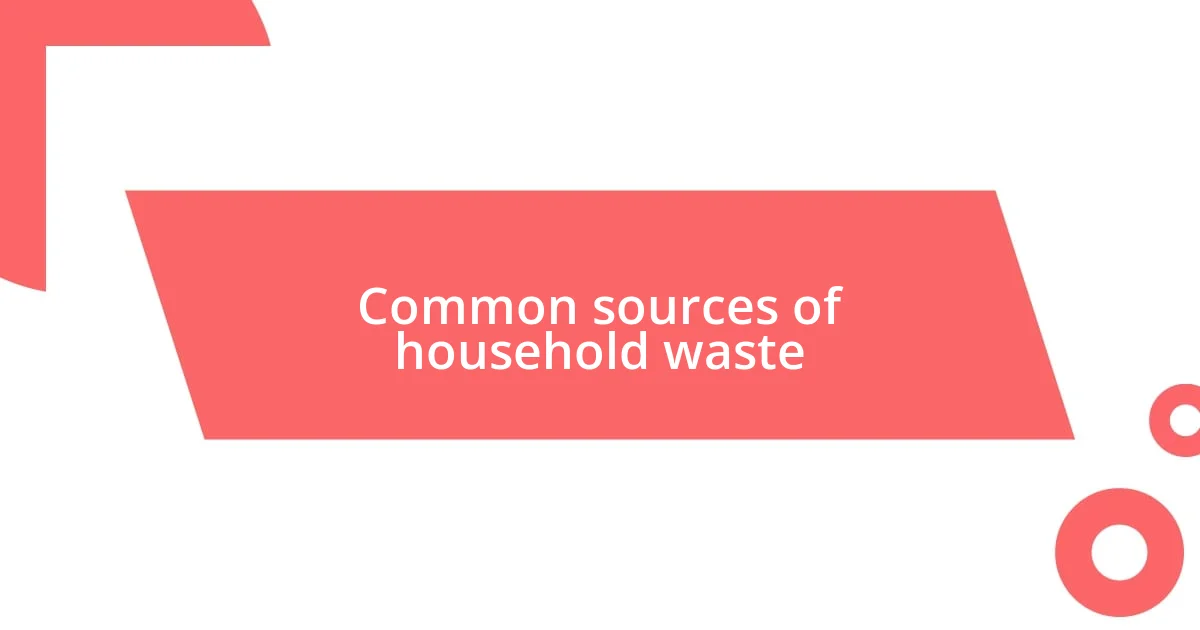
Common sources of household waste
Many moments in my daily life remind me of the common sources of household waste that often go unnoticed. Take, for instance, the packaging that arrives with online orders. I’ve found myself opening a box only to be met with a cascade of plastic, foam, and cardboard. It’s a stark reminder that our convenience can lead to a surprising amount of trash.
Here are some of the most common contributors to household waste:
- Food waste: Spoiled groceries or uneaten leftovers.
- Packaging waste: Plastics, cardboard, and Styrofoam from purchased products.
- Electronics: Broken gadgets and batteries that get tossed aside.
- Clothing: Unwanted garments that are often discarded instead of donated.
- Cleaners and personal care products: Empty bottles and containers that pile up.
I’ve started to consciously rethink each of these sources. For example, since reducing how often I buy new clothes, I’ve noticed a significant decrease in my waste. I now cherish the items I do own more deeply, which has shifted my mentality on consumption altogether. This transition has led to a more intentional and rewarding way of living, sparking joy rather than clutter.
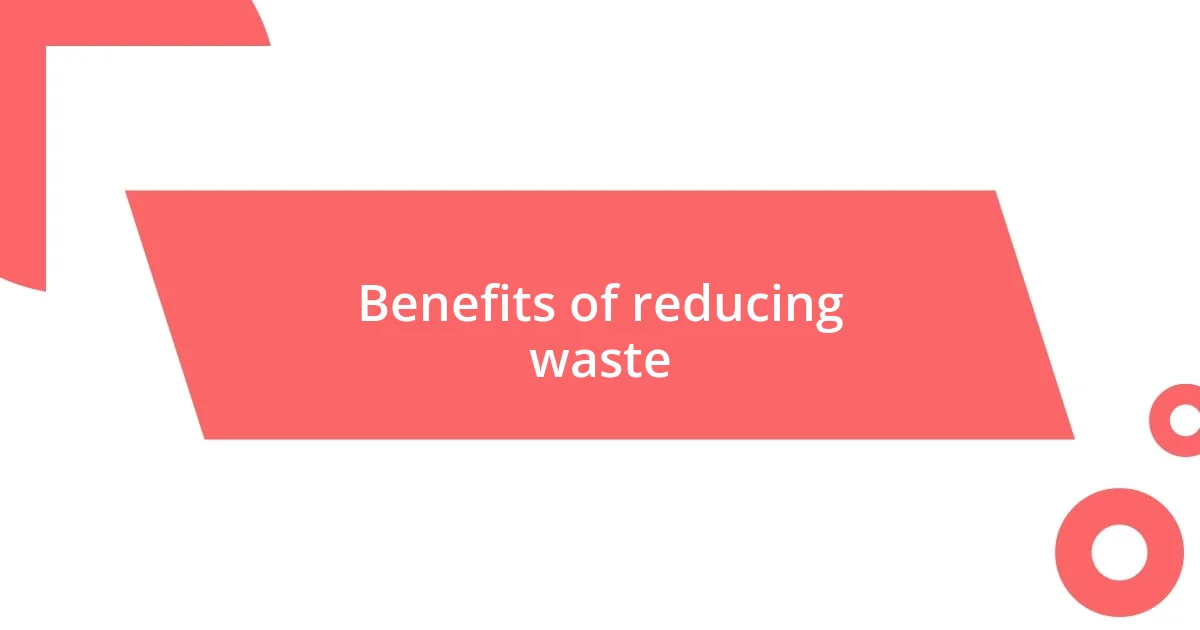
Benefits of reducing waste
Reducing waste brings an array of benefits that extend beyond just keeping your home tidy. One of the most impactful aspects is the financial savings. I remember when I first embraced meal prepping; not only did I waste less food, but I also saved money on groceries. Seeing my expenses decrease while my waste did the same was profoundly satisfying. Have you ever calculated how much money you could save by cutting down on unnecessary purchases?
Additionally, reducing waste contributes to a healthier planet. The less we throw away, the fewer resources are consumed to produce new items, and that means less energy and water are wasted. I’ve noticed that being mindful of my consumption has inspired me to support local businesses and sustainable brands. This shift not only enriches my community but also strengthens the bond I feel with the environment. It’s like a gentle reminder that my choices matter.
Lastly, the emotional benefits of waste reduction can be quite liberating. I often find myself feeling lighter and more at peace when I declutter my space and minimize waste. The act of simplifying my life, whether it’s through composting or donating old clothes, has brought me a sense of accomplishment. Have you felt that rush of joy when you make a responsible choice? It’s a reminder that small actions lead to significant ripples of change in the world around us.
| Benefit | Description |
|---|---|
| Financial Savings | By buying only what you need, you directly reduce your spending. |
| Environmental Health | Lower waste means less resource consumption, leading to a healthier planet. |
| Emotional Well-being | Reducing clutter can bring peace of mind and a sense of accomplishment. |
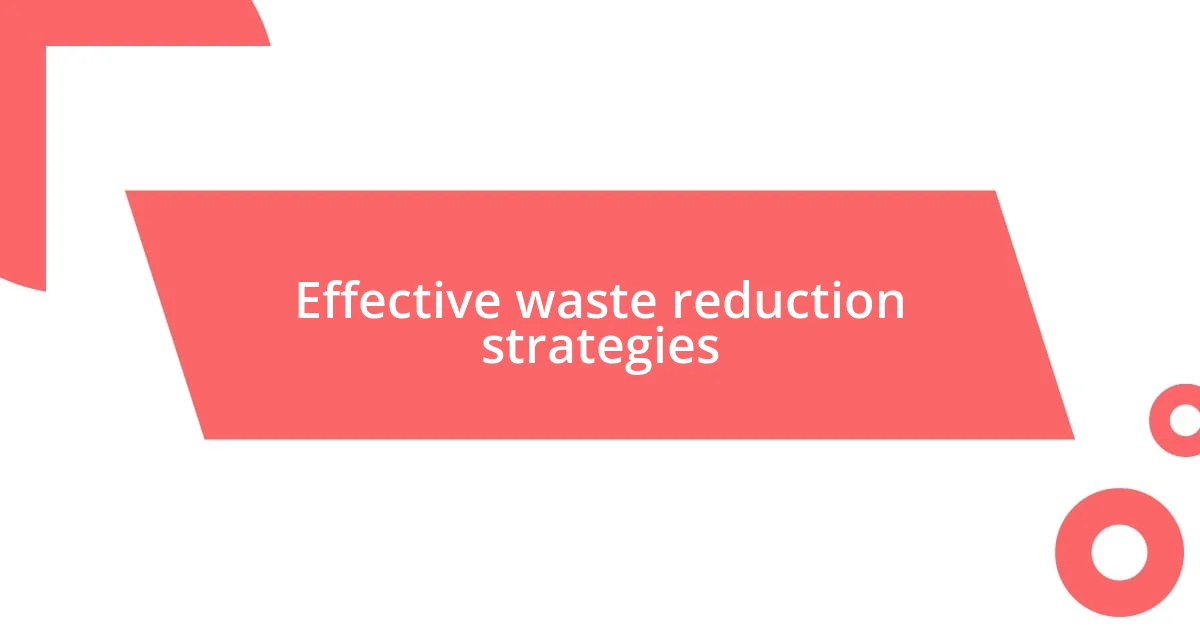
Effective waste reduction strategies
Shifting my perspective on shopping has been one of the most effective strategies for reducing waste in my household. Instead of reaching for new items, I’ve begun exploring second-hand stores and swapping clothes with friends. This practice not only cuts down on packaging waste but also breathes new life into clothing that might otherwise end up in landfills. Have you ever discovered a hidden gem at a thrift store? The thrill of finding something unique makes the experience even more enjoyable.
Another strategy I’ve found successful is meal planning. At the start of each week, I take a little time to map out what I’ll eat, focusing on using what I already have in my pantry. This not only minimizes food waste but has also made grocery shopping more efficient. Each time I see an empty fridge at the end of the week, I can’t help but feel proud. Isn’t it satisfying to turn leftovers into delicious meals rather than letting them spoil?
Composting has also become a game-changer for my household waste. Instead of tossing vegetable scraps and coffee grounds in the trash, I’ve started a small compost bin in my kitchen. It feels incredible to see how these once-discarded items can transform into nutrient-rich soil for my garden. Have you ever tried composting? Not only does it reduce my waste, but it also connects me more deeply with the cycle of growth and decay, reminding me that even waste can nourish life.
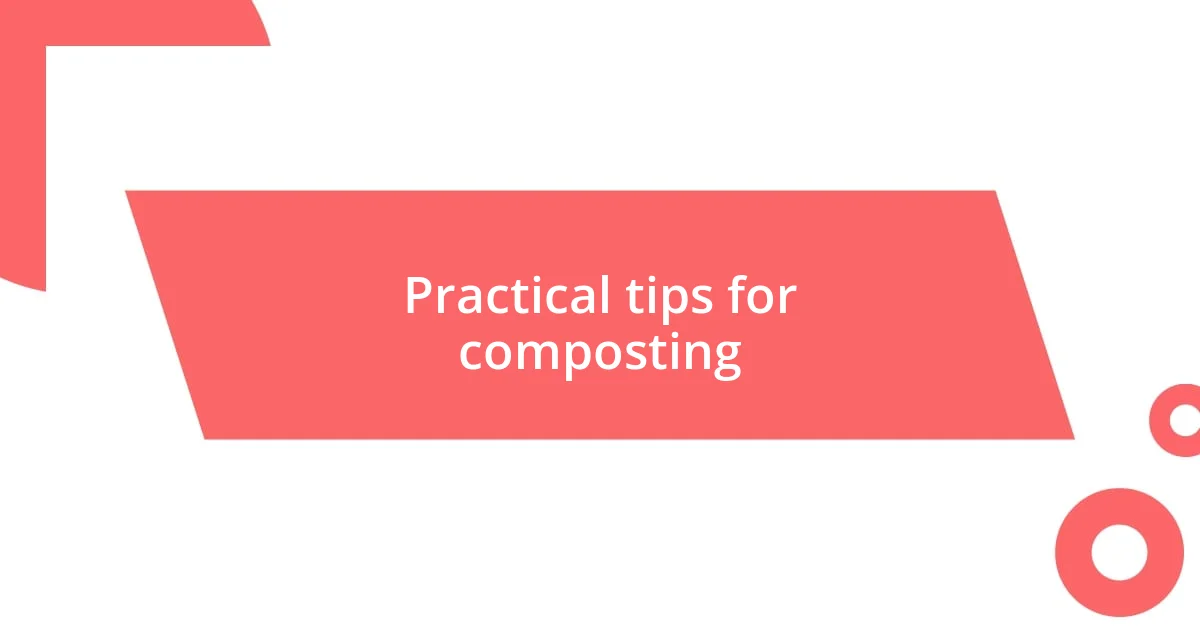
Practical tips for composting
Starting a compost bin in my kitchen was one of the easiest decisions I’ve ever made. I remember feeling a mix of excitement and apprehension when I collected my first batch of kitchen scraps. Watching those veggie peels and coffee grounds transform into nutrient-rich soil felt like magic, and it ignited a sense of purpose in my gardening. Have you ever experienced that thrill of turning something once deemed as trash into something valuable?
To keep my compost healthy, I’ve learned to balance “greens,” like fruit scraps and coffee grounds, with “browns,” such as dried leaves and cardboard. At first, I didn’t pay much attention to this ratio; my compost would sometimes get smelly, which was discouraging. But after a bit of research, I found that maintaining that balance made all the difference. Isn’t it fascinating how a bit of knowledge can enhance our efforts? Now, sparking that microbial action feels like I’m collaborating with nature.
I also discovered that what I choose to add to my compost matters. For instance, I used to throw in all my leftover food without much thought, but I learned to avoid dairy and meat since they attract pests. When I finally made this switch, I realized that even small adjustments can lead to better results. It’s like a journey of learning, where each successful composting batch brings me closer to nurturing my garden. Have you been surprised by the learning curves in your own waste reduction journey? Embracing these changes can significantly elevate the rewards of composting!
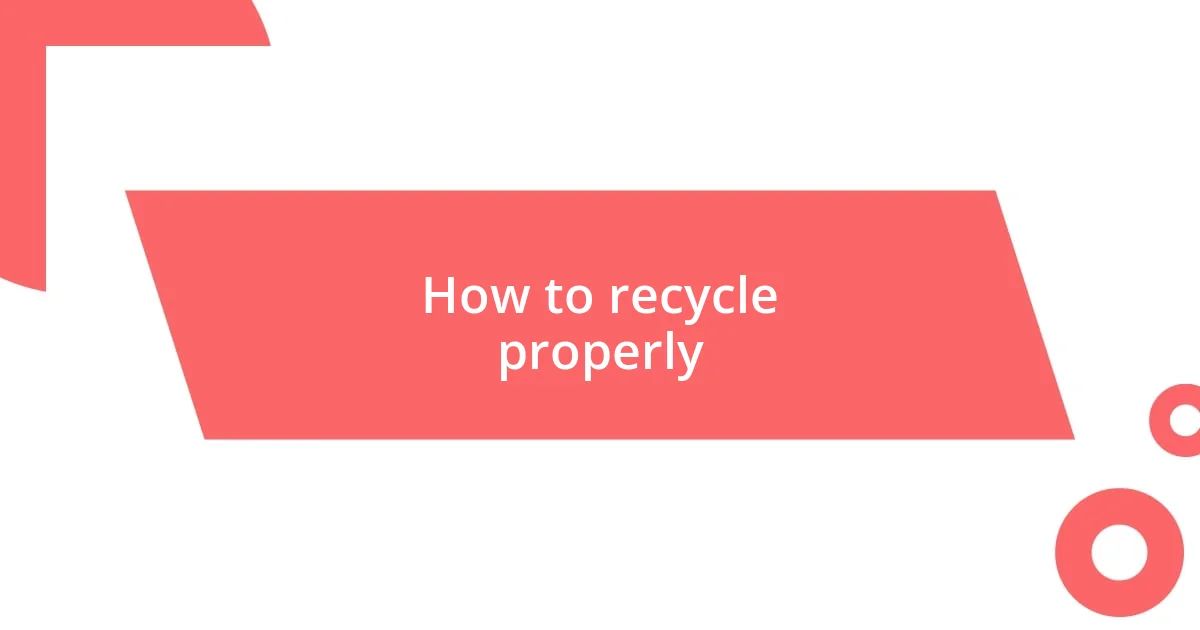
How to recycle properly
Recycling is often more complicated than it seems, and I’ve learned that doing it properly can significantly impact the environment. When I first started, I assumed all plastics were recyclable, but I quickly discovered that not all numbers and symbols mean the same thing. Now, I make it a point to check recycling guidelines in my local area—it’s eye-opening how many materials can be diverted from the landfill with a bit of research.
I also remember my initial struggle with cleaning recyclables before disposal. I used to think, “Why go through the hassle?” But washing out containers and removing labels are essential steps that help prevent contamination. One day, I was about to toss a greasy pizza box when I recalled the guidelines—this small act made all the difference in keeping my recycling stream clean and efficient. Have you ever thought about how one thoughtful action can ripple out to benefit the community?
Lastly, I advocate for keeping an organized recycling station at home. Initially, I jumbled everything together, and it became a frustration. Now, I have clearly labeled bins for paper, plastic, and glass. This simple setup has not only streamlined my process but has also become a fun family activity. Involve your kids or roommates in sorting waste; you might be surprised by how much they enjoy learning the importance of recycling. How do you think a little team effort could change the way your household engages with recycling?
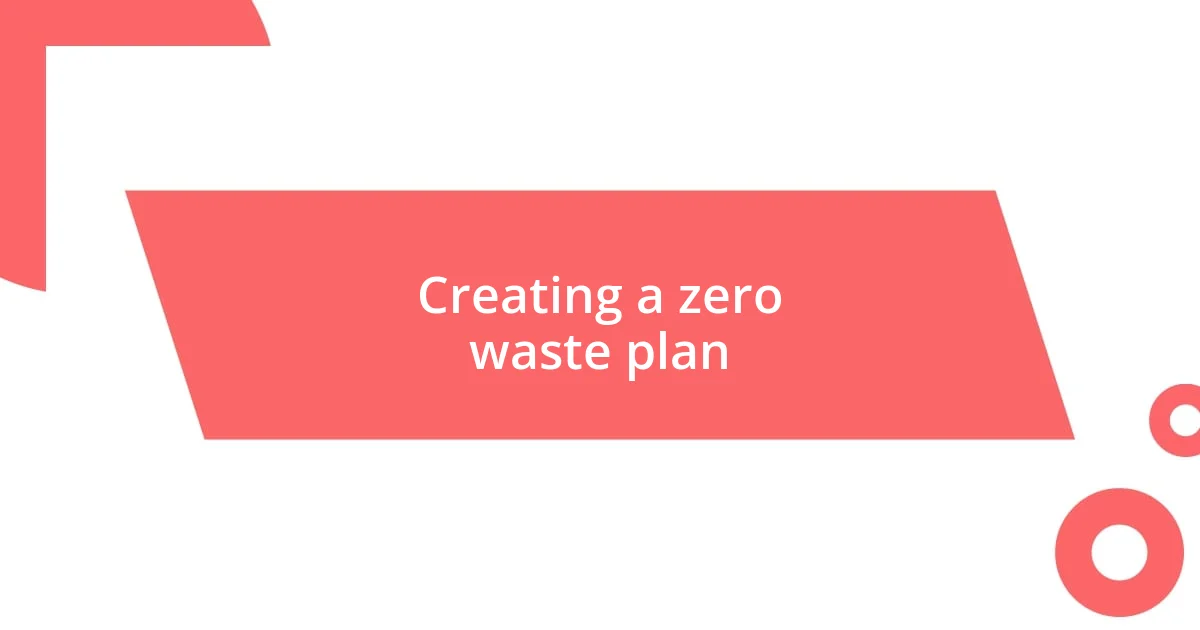
Creating a zero waste plan
Creating a zero waste plan is a transformative journey, and starting with a clear, actionable approach can truly set the tone. I remember sitting down with a notebook and brainstorming what my family could realistically cut out. It was empowering to see our commitment written out, and when I set specific goals—like reducing single-use plastic—we began to think creatively about alternatives. Have you ever felt that spark when you realized you could change your habits?
As we ventured further into this zero waste lifestyle, I found that tracking our progress was key to staying motivated. I created a monthly checklist to see what we were eliminating and where we could improve. Reviewing our results not only gave me a sense of accomplishment but also highlighted areas we were still struggling with, like buying bulk items instead of packaged goods. Reflecting on my journey, don’t you think small, consistent changes can lead to significant impacts over time?
One pivotal moment came when I realized that involving my community could multiply our efforts. I hosted a small swap party with friends, where we exchanged items instead of throwing them away. Witnessing the joy of someone finding a new home for their unwanted items was heartwarming. It was more than just reducing waste; it became about building connections. Have you considered how collaborating with others could amplify your zero waste goals?










